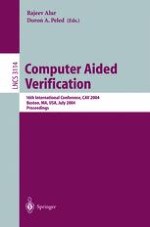2004 | Buch
Computer Aided Verification
16th International Conference, CAV 2004, Boston, MA, USA, July 13-17, 2004. Proceedings
herausgegeben von: Rajeev Alur, Doron A. Peled
Verlag: Springer Berlin Heidelberg
Buchreihe : Lecture Notes in Computer Science
Enthalten in: Professional Book Archive
